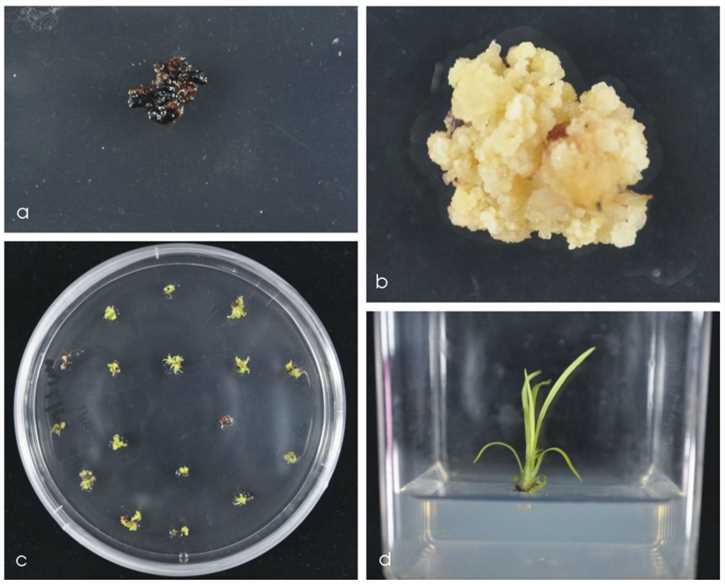Saccharum officinarum L., also known as sugarcane, is a plant belonging to the genus Saccharum of the Gramineae. Saccharum officinarum L. is a perennial tall solid plant and raw material to produce sucrose. Sugar is one of human necessities. Sucrose accounts for about 65% of the world's total sugar production. It is also an important raw material for the food industry such as candy and beverages. In addition, Saccharum officinarum L. contains various vitamins, fats, proteins, organic acids, calcium, iron, and other substances that are very beneficial to human metabolism. At the same time, sugarcane can also be extracted from ethanol as an energy substitute, and it is an important raw material for chemical industry and energy production. In order to further improve the nutritional value and industrial value of Saccharum officinarum L., reduce the cost of cultivation process, research on genetically modified Saccharum officinarum L. has become a hot field in recent years. Lifeasible has developed a sophisticated sugarcane transformation platform to help you get sugarcane with strong stress tolerance and excellent traits.

Lifeasible provides one-stop services, covering all steps including experimental design, vector construction, plasmid transformation, positive transplant screening and characterization of transgenic Saccharum officinarum L. We offer Saccharum officinarum L. transformation using various genetic engineering technologies as follows:
Gene overexpression is a common technique for studying gene function. The development and utilization of gene overexpression has brought us many conveniences for studying gene function and improving the yield of target products. Through the quantitative overexpression of genes related to sucrose, glucose, fructose, citric acid and other chemical components in Saccharum officinarum L. can be increased. We could help you overexpress many genes including insect resistance gene BCG17, gene ScPR1 that responds to the infection of red stripe, SoSUT5 gene related to sugarcane growth and sucrose accumulation, low temperature stress gene SoTUA, gene SoACLA-1 related to plant stress resistance, and many other genes related to important traits of Saccharum officinarum L.
RNAi technology is widely used in the field of gene editing, it is a phenomenon of specific gene silencing mediated by double-stranded RNA (dsRNA) at the transcription level and translation level. Through RNAi technology, we can achieve silencing of multiple genes in Saccharum officinarum L.
Virus induced gene silencing (VIGS) is a genetic technology that inhibits the expression of endogenous genes in plants by inserting recombinant viruses into target gene segments, they can induce plant endogenous gene silencing and cause phenotypic changes, and then study the function of target genes based on phenotypic changes. The VIGS technology is a method of transient transformation and thus can help our customers save time and obtain valuable information for gene functional analysis. With wealth of experience in VIGS, our scientists can provide you with customized protocol for VIGS in Saccharum officinarum L.
CRISPR gene knockout technology is currently the most widely used gene knockout technology, it provides us with a very powerful and convenient gene editing tool. As a leading company that has been deeply involved in the field of gene editing for many years, using CRISPR technology, we can knockout Saccharum officinarum L. genes in different ways, including frameshift mutations, multiple deletion of fragments, knockout of non-coding genes, knockout of multiple copies of genes, etc.
Using the powerful scalability of the CRISPR system, we have developed many methods that can improve gene knock-in efficiency and achieve precise editing of the Saccharum officinarum L. genome. Most of CRISPR gene knock-in is done through HDR. Therefore, we have developed different methods to increase the probability of HDR, thereby improving the efficiency of gene knock-in.
CRISPR single base editing technology is a hot area of life science research today. As a company that has been cultivating gene editing technology for decades, Lifeasible could help you achieve the conversion from C to T or A to G in Saccharum officinarum L. using CBE and ABE, both of which rely on the DNA positioning capabilities of the CRISPR/Cas9 system. During single base editing, the C base deaminase or A base deaminase is located at a specific position in the genome, and it catalyzes the deamination reaction of C or A at a specific position and turns it into U or I. Then it is treated as T or G in the process of DNA replication, realizing the conversion from C to T or A to G.
Sequence-specific control of gene expression on a genome-wide scale is an important approach for understanding gene functions and for engineering genetic regulatory systems. There are many ways to participate in the inhibition of gene expression, one of them is CRISPR Interference (CRISPRi). For the inhibition of Saccharum officinarum L. genes, we can provide a variety of solutions, including dCas9 binding to targeted DNA and realizing Inhibition of gene transcription through steric hindrance. In addition, gene knockdown can also be achieved by recruiting a fusion protein to the start site of gene transcription.
CRISPRa technology uses the powerful capabilities of Cas9 and sgRNA to fuse or recruit multiple proteins to enhance gene transcription. For Saccharum officinarum L. genes, we provide VPR technology, SAM technology and Suntag technology to allow the CRISPR system to carry more activation element and achieve a stronger activation effect after synergistic amplification.
The study of gene function has always been the core subject of biological research. The earliest genetic screening system established through forward genetics is very inefficient and has a huge workload. However, the reverse genetic screening system based on CRISPR technology can complete very low-cost mutation library construction work. The gene mutation library construction technology we provide for Saccharum officinarum L. including gene knockout library construction, gene knockdown library construction, and gene activation library construction. Moreover, single-cell sequencing is available for mutation screening.
DNA-free gene editing technology has received extensive attention from the industry in recent years. We provide DNA free Saccharum officinarum L. genome editing services, including transient expression of CRISPR/Cas9 plasmid DNA, in vitro transcription of CRISPR/Cas9, and pre-assembled ribonucleic acid composed of purified Cas9 protein and sgRNAs complex. These technologies can avoid the integration of foreign DNA and genome, and reduce off-target effects. In addition, compared with traditional techniques, these techniques can avoid the use of hybridization or backcrossing to isolate CRISPR/Cas9 chimeras, so they are cheaper and have shorter experimental cycles.
Genetic Transformation Process for Saccharum officinarum L.
Plant gene transformation technology is a basic technology for studying plant gene functions and obtaining excellent plant traits. So far, the most advanced and widely used method for the development of genetically modified Saccharum officinarum L. is Agrobacterium-mediated transformation (Figure 1).
 Figure 1. Different steps involved in in vitro culturing of Agrobacterium mediated transformation of Saccharum officinarum L., (A) Non-transgenic control (C1), callus inoculated with LB media and then placed on callus induction medium with selection, (B) Embryogenic callus placed in callus induction medium, (C) Callus regeneration after inoculation on regeneration medium, (D) Putative transgenic plant on rooting medium with selection. (Fiaz R, et al. 2014)
Figure 1. Different steps involved in in vitro culturing of Agrobacterium mediated transformation of Saccharum officinarum L., (A) Non-transgenic control (C1), callus inoculated with LB media and then placed on callus induction medium with selection, (B) Embryogenic callus placed in callus induction medium, (C) Callus regeneration after inoculation on regeneration medium, (D) Putative transgenic plant on rooting medium with selection. (Fiaz R, et al. 2014)
We provide multiple Agrobacterium strains (C58, LBA4404, EHA105, GV2260, GV3101), as well as commercial and customized binary vectors with variant selectable markers (Kanamycin, Hygromycin, Phosphinothricin, G418, etc.). Experts at Lifeasible obtain comprehensive knowledge and years of experience to solve technical problems and challenges in Saccharum officinarum L. transformation. Our tailored solutions can help our customers achieve the goals. For more information or any inquiry requirements, please contact Lifeasible. We are at your service 24 hours a day.
Reference